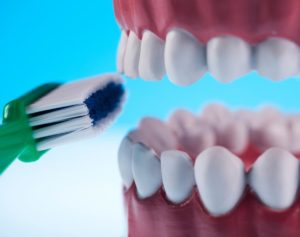What You Need to Know About Treating Gum Disease
 Gum disease is surprisingly common, and most people don’t even realize they have it. It’s easy to ignore the first few signs, but it can become serious fast. Periodontitis, or gum disease, is a risk factor for more complicated issues, like heart and lung diseases, which is why treating it as soon as possible is so important.
Gum disease is surprisingly common, and most people don’t even realize they have it. It’s easy to ignore the first few signs, but it can become serious fast. Periodontitis, or gum disease, is a risk factor for more complicated issues, like heart and lung diseases, which is why treating it as soon as possible is so important.
The first thing any dentist or periodontist will recommend is to have a deep-scale cleaning. This is a more in-depth version of your regular cleaning that allows for your hygienist to clean beneath your gum line, and remove the bacteria lurking there.
But sometimes, a deep-scale cleaning simply isn’t enough. That’s when Arestin comes into play. One of the best ways to treat advanced gum disease is with the antibiotic treatment Arestin. But, what is it and how does it work?
Here’s everything you need to know about Arestin:
What is Arestin?
Arestin is an effective gum disease treatment that your dentist will place on the infected areas of your mouth. The antibiotic treatment comes in powder form and is placed inside the infected periodontal pockets only after your dentist finishes the scaling and root planing procedure, which is non-surgical and involves the removal of dental plaque and tartar by deep cleaning above and below the gum line. Arestin remains active, releasing antibiotics in these pockets for an extended period of time. This helps keep bacteria at bay even when you’re going about your life. Cool, huh?
How Does Arestin Work?
The Arestin powder contains tiny bead-like particles that are filled with the antibiotic minocycline. This antibiotic is released for up to 21 days into the infected area, killing the bacteria already there. The use of this antibiotic is important in controlling gum disease and stopping the bacteria that causes it from coming back.
Results, and aftercare
Arestin is nearly two times more effective than the scaling and root planing process alone. After the treatment using Arestin, it’s important that you avoid touching the treated areas, resume your normal brushing routine 12 hours after treatment, wait 10 days to floss or waterfloss, use toothpicks, and avoid eating hard, crunchy, or sticky foods for one week. It’s also extremely important that you go to your follow-up appointments. Gum disease can come back, so your dentist will want to check for signs of periodontitis regularly.
If you’re struggling with gum disease, give us a call. We can help you decide which treatment option is best for you!

